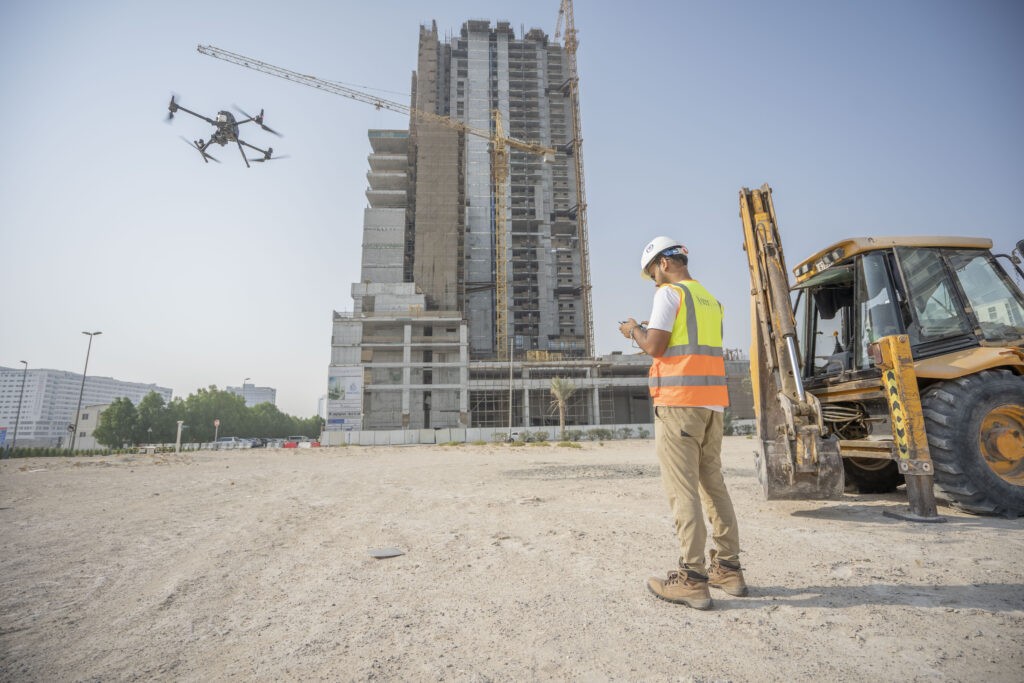
The Pearl Building Rating System under the Estidama initiative is a comprehensive set of standards and criteria for the design, construction, and operation of sustainable buildings in Abu Dhabi. Estidama is part of a larger sustainability framework, the Abu Dhabi 2030 Urban Structure Framework, which is aimed at creating a sustainable urban environment. Now, with the help of drones, construction companies in Abu Dhabi are meeting the requirements of the Pearl Building Rating System.

Estidama looks at the building’s energy efficiency, water efficiency, air quality, waste management, transport, green space, and other factors. For the building to be certified by the Estidama rating system, each of these factors must meet certain criteria and standards. We are using drones to assess and monitor construction projects while providing crucial data that helps companies ensure compliance with the Estidama standards.
Drone data is utilized to monitor the environment around the construction site and assess the impact of the building on its surroundings. By using drones, construction companies are constructing buildings that are more sustainable than before. While the drone provides a method to keep track of resource usage, it also tracks the construction progress, which helps keep the project on track and under budget.
In addition to helping construction companies comply with Estidama’s standards, reduce their costs, and save time, drones are also helping to improve the safety of construction sites in Abu Dhabi. Drones can be used to monitor construction sites for potential hazards and take corrective action if needed. Drones can also be used to keep an eye on the environment around a construction site to make sure that the building doesn’t hurt it.

Benefits of using drones to monitor construction progress.
Drones can help obtain a variety of Estidama-relevant data, including:
When considering the Estidama regulations, there are numerous ways to comply with the regulations, with both traditional and modern methods of construction. Both options come with their own unique advantages and drawbacks.
In comparison, traditional methods of construction monitoring or data collection are a time-consuming and arduous process. This is made worse by an inefficient flow of information; the inspector will have to coordinate with multiple contractors to obtain the relevant information. Then reports will have to be generated and passed along the chain to the stakeholders. The traditional method is taxing on the inspector and inefficient at making the relevant information easily available.
When it comes to meeting the Pearl Building Standards, drones provide a more comprehensive approach for construction projects. By providing a detailed overview of the site, drones can help identify any potential issues before the construction process begins. The drone data can also be integrated with reporting and analytics software, or BIM software, to provide the data and reports to the relevant parties and stakeholders.
Furthermore, drones will also be used to monitor the construction process, which is essential for compliance with Estidama regulations. This process allows construction workers to monitor the progress of the project and make sure that all regulations are being followed. Traditional ways of building, on the other hand, require manual inspections, which can take a long time and be hard to manage.
Drones are an important tool for construction companies looking to comply with Estidama standards. Drones provide a cost-effective and efficient way to assess and monitor the progress of construction projects, while also helping to create a more sustainable built environment. By providing accurate data, drones can help construction companies ensure that their projects are in compliance with Estidama standards.
With their powerful sensors enabling construction companies with actionable information drones are a must-use to effective meet requirements and achieve Pearl Ratings.
Article original source: Drones Are Helping Construction Projects in Abu Dhabi Adhere to Estidama (feds.ae)